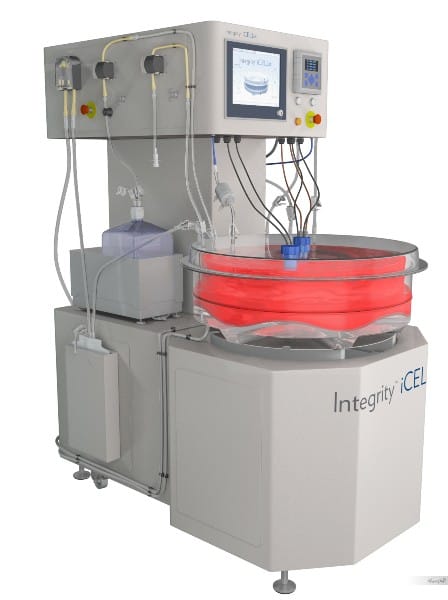Companies who manufacture biotechnology products such as monoclonal antibodies, therapeutic proteins and vaccines, produce a wide range of products in small amounts. They need to switch quickly between different production processes. The standard Inox containers are no longer the best fit for these novel high-tech needs. Single-use bioreactors may be the ideal solution: these “bag-in-box” reactors fit the old Inox containers, and allow companies to start production immediately.
Inox reactors used to be the standard vessels for storage, transport and mass production of pharmaceuticals components. Perfect solutions for factories that were focused on the production of one agent. However, these containers require thorough cleaning and sterilization when switching to a different production process. This can take several days and includes rigorous quality checks such as microbiological sample analysis. Cleaning of reactors is a labor-intensive and costly process.
However, new solutions have appeared on the market for the manufacturing of multiple biotech-components: single-use bioreactors. These new single-use bioreactors come with huge economic advantages.
Saving costs and energy with disposable bioreactors
It may seem contradictory, but single-use bioreactors can save you money:
- Cleaning of an Inox tank and pipelines requires a wash with an acid or base solution, followed by sterilization with steam. Without these steps, the investment costs can decrease up to 40 – 50%
- Single-use bioreactors provide a huge amount of flexibility. They are sterile upon delivery and allow for the production of different components
- The risk of contamination is greatly reduced. This is especially important in the production of vaccines and monoclonal antibodies
- The time required to set-up the production process for a new biologic or biotechnology product decreases from a couple of days to a couple of hours.
Additionally, cleaning of Inox containers requires a huge amount of water, about 5 times the volume of the tank, and a tremendous amount of energy is needed to perform the steam sterilization. In total, cleaning of an Inox container results in a bigger carbon footprint than the use of a single-use bioreactor. After usage, the single-use reactors are collected by a specialized company that processes them in an incinerator and recuperates the heat as an energy source.
Solution for the entire process
Single-use bioreactors and single-use mixing systems were originally developed by ATMI. In 2014, ATMI was acquired by PALL. This acquisition was a complimentary addition to PALL’s existing single-use line that was mainly focused on downstream processing with its expertise in chromatography, filters and sterile connectors. “Companies used to buy a mixer, a reactor, afilter system… all separately. But now, the market demands a one-brand approach. We combine the delivery of a bioreactor with mixing and storage systems. PALL is traditionally strong in automation due to its history in the stainless steal business. The company uses its engineering capability to offer an integrated solution for an entire process,” explains Mario Philips, President Single-Use Technologies at Pall Life Sciences, who led the integration of ATMI into PALL. “Our worldwide infrastructure with centers of excellence in Germany, India, Shanghai and Boston are continuously optimizing the combination of the different single-use products. PALL is amongst the most advanced players in this field,” adds Phililps.
Single-use biocontainers are available in volumes between 50 to 3000 liters. “A new batch can be set-up in a couple of hours, this a huge benefit. The biocontainers come with integrated sterile connection and can contain single-use sensors to measure pH, oxygen and conductivity,” continues Philips, “I am really excited to work in this field because single-use technology can really make a difference in producing biotechnological products cheaper. This is very important, for example, in the production of vaccines for emerging countries.”


